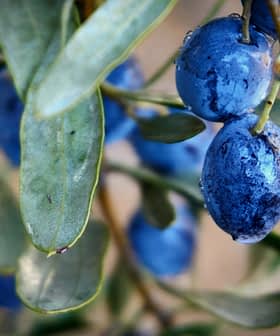
How good a specific extra virgin olive oil is for your health could be easier to assess with a new Greek system to measure and rate the content of key olive compounds oleocanthal and oleacein.
Oleocanthal has anti-inflammatory effect similar to Ibuprofen and Oleacein is a powerful antioxidant, but until now they have been difficult to analyze chemically, according to Dr. Prokopios Magiatis, assistant professor of pharmacognosy and natural products chemistry at the University of Athens.
At the recent Terra Creta Olive Oil Conference on Crete, Magiatis said he and his team from the university had developed a method using 1H-NMR, a form of nuclear magnetic resonance, to directly measure oleocanthal and oleacein levels.
“The new method makes it possible to identify differences between extra virgin olive oils and to classify them according to their potential health effects” he said.
Inspiration from ancient medics
Ancient Greek doctor Dioscorides piqued the researchers’ interest. “He, and others after him, insisted that the best health effects come from fresh olive oil from unripe olives, or from specific varieties.”

This set them investigating ways to pinpoint what molecules were responsible for health effects and to compare olive oils based on their contents of them.
Five years later, they have developed an NMR test that just takes 50 seconds.
“You can analyze hundreds of samples in a very short time but of course you need a very expensive instrument and we’re happy to have one in our lab in Athens” Magiatis said.
New indexes proposed
The team homed in on the key olive polyphenols oleocanthal and oleacein and rates EVOOs according to both the sum of their levels of these molecules, index D1, and to their oleocanthal to oleacein ratio, index D2.
“D is for Davis because this study was done in collaboration with the UC Davis Olive Center” Magiatis said. He and Dr. Eleni Melliou, a co-author of the study, were visiting scientists at UC Davis in 2011. Dan Flynn, the Olive Center’s director, gave them advice and oil samples.
The new system was applied to more than 250 samples from monovarietal olive oils from Greece and California over two years and, according to Magiatis, revealed big differences between oils.
“Among the nineteen varieties studied, the highest concentration was found in Koroneiki olive oil and it’s very good for Greece because more than 70 percent of its olive trees are this variety.” Non-Greek varieties grown in California, like Barouni, Leccino, and Mission, also had high concentrations. Wider studies are needed of other varieties around the world, he said.
High heat in mill, less healthy oils
Processing temperature is another factor affecting oleocanthal and oleacein levels.
“When we test the same olive fruit in the same olive mill but using different temperatures you can see a huge difference in the concentration of these compounds, with high temperatures having negative effects” he said.
The trial also revealed a positive link between early harvesting and high levels of both compounds. Some olive varieties, however, deliver low levels regardless of geographic origin, harvest time or if best practices are followed.
Oils with high levels of oleocanthal and oleacein retained most of this content even 18 months after harvest.
Olive oil heart-health claim
When last year the European Food Safety Authority approved the claim that consumption of olive oil polyphenols protects LDL particles from oxidative damage, it said this hinged on the daily consumption of “5mg of hydroxytyrosol and its derivatives (e.g. oleuropein complex and tyrosol) in olive oil”.
Magiatis said the new method made it possible to measure all the compounds mentioned by EFSA in one experiment. “And we can provide the necessary data for the health claims.” The latter could help producers of olive oils with high quantities of hydroxytyrosol gain better prices.
Why oleocanthal and oleacein?
Oleocanthal and oleacein were of most interest to the team as they are the two most abundant forms of conjugated hydroxytyrosol and tyrosol in the olive oils they studied.
“Oleacein is a derivative of oleuropein and the most powerful antioxidant constituent of olive oil” Magiatis said.
Oleocanthal is said to have potential to inhibit tumor growth, to offer protection against Alzheimer’s disease and to be a COX‑1 and COX‑2 inhibitor.
It is responsible for the pungency that comes from unripe olives in fresh olive oil and that irritates the throat.
“Chronic exposure to low doses of anti-inflammatory agents like oleocanthal offers protection against cardiovascular diseases and aging” he said.
Applications: extra virgin olive oil as a new drug?
As for potential applications of his research, Magiatis said one use could be to target specific olive oils at people with heart disease.
However, consumers will need education to accept and value the taste of oils with very high levels of potential health effects because they are usually more pungent and bitter.
“It will be difficult for producers to achieve a balance between taste and high concentration of specific polyphenols” Magiatis said.
At the same time, the new index can help correlate the organoleptic properties of an olive oil, predicting what pungency and bitterness should be expected.
“What we have provided is a powerful new tool for the evaluation of olive oil quality” Magiatis said.
“Not all extra virgin olive oils are the same. Some present great potential as health protecting or therapeutic agents and we have provided the scientific community with a new index offering an estimate of these health related properties.”
footnote: Magiatis and his research colleagues recently published a paper relating to their research in the Journal of Agricultural Food Chemistry.
Titled “Direct Measurement of Oleocanthal and Oleacein Levels in Olive Oil by Quantitative 1H-NMR. Establishment of a New Index for the Characterization of Extra Virgin Olive Oils”, it is available here: http://pubs.acs.org/doi/abs/10.1021/jf3032765
The researchers are: Evangelia Karkoula , Angeliki Skantzari , Eleni Melliou , and Prokopios Magiatis.
Sources:
Link to Journal of Agricultural Food Chemistry paper “Direct Measurement of Oleocanthal and Oleacein Levels in Olive Oil by Quantitative 1H-NMR. Establishment of a New Index for the Characterization of Extra Virgin Olive Oils“
Olive oil health claim approved by EFSA








